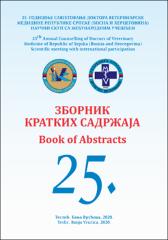Karakter patomorfoloških promena najčešćih pneumonija kod svinja na teritoriji Republike Srbije

View/
Date
2020Author
Vučićević, Ivana
Prodanov-Radulović, Jasna
Polaček, Vladimir
Aleksić-Kovačević, Sanja
Metadata
Show full item recordAbstract
Swine respiratory diseases have been significantly put under control in the
Republic of Serbia during the past decade, due to the implementation of
appropriate prophylactic measures and diagnosis. Despite the reduced incidence
of pneumonia on swine farms, respiratory diseases are still one of the most
important health problem in modern pig breeding. The most common causes of
bacterial pneumonia among the examined material from pig farms in Vojvodina
(Serbia) are Actinobacillus pleuropneumoniae, Pasteurella multocida, Bordetella
bronchiseptica and Haemophilus parasuis. These pathogens are most commonly
diagnosed in feral pigs. Bacterial pneumonias are usually secondary infection
manifest as exudative pneumonias that can be purulent (Pasteurella multocida,
Mycoplasma hyopneumoniae), or apostematous (Bordatella bronchiseptica,
Actinomyces pyogenesu) or fibrino-purulent (Haemophilus parasuis) and fibrinohemorrhagic
bronchopneumonia (Actynobacillus pleuropneumoniae), mainly
accompanied by fibrinous pleurisy. Purulent bronchopneumonias are
characterized by the accumulation of purulent exudate in the airways and have a
lobular distribution. Fibrinous bronchopneumonias are characterized by the
accumulation of fibrin in the bronchoalveolar spaces, with changes affecting
entire lobes. Bacteria that cause fibrinous bronchopneumonias damage blood
vessels and cause changes that can be classified into stages of splenization, red
hepatization, gray hepatization and resolution. Viral pneumonias are more often
diagnosed in domestic swine, primarily caused by swine reproductive and
respiratory virus, influenza virus, circovirus type 2, as well as Aujeszky's disease
virus. Viral pneumonias in swine are acute interstitial pneumonias in which the
exudative and proliferative phases can be distinguished. During the acute phase,
"fetalization of the lungs" can occur, which is characterized by a reduced alveolar
spaces and thickened alveolar walls.
The lungs affected by interstitial pneumonia are rubbery and a rib imprint can be
seen on the surface. In addition to bacterial and viral, verminous pneumonias arecommon in swine. Although the morphological characteristics of bacterial and
viral pneumonias can be clearly distinguished, it is important to emphasize that
the pathogenesis of swine respiratory diseases often involves several different
agents and that the changes depend on the dominant etiological agent.
